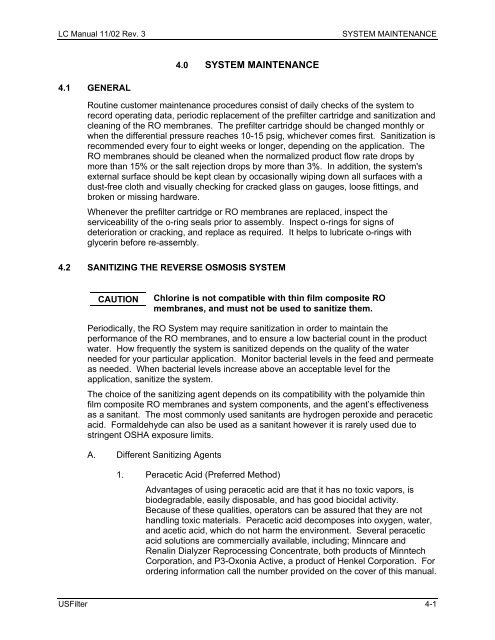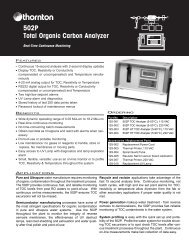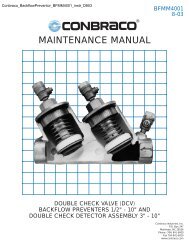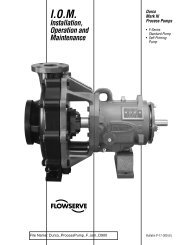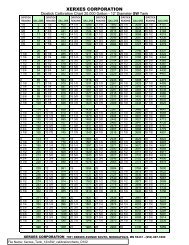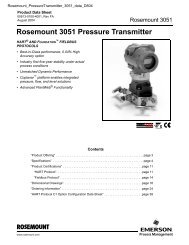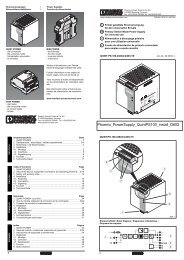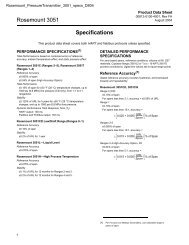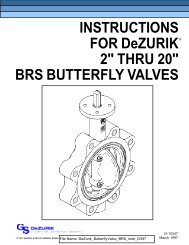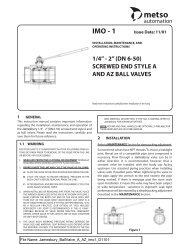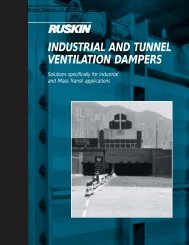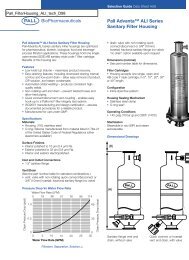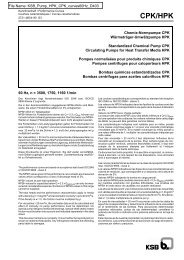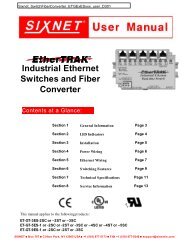Operation and Maintenance Manual for
Operation and Maintenance Manual for
Operation and Maintenance Manual for
You also want an ePaper? Increase the reach of your titles
YUMPU automatically turns print PDFs into web optimized ePapers that Google loves.
LC <strong>Manual</strong> 11/02 Rev. 3 SYSTEM MAINTENANCE<br />
4.1 GENERAL<br />
4.0 SYSTEM MAINTENANCE<br />
Routine customer maintenance procedures consist of daily checks of the system to<br />
record operating data, periodic replacement of the prefilter cartridge <strong>and</strong> sanitization <strong>and</strong><br />
cleaning of the RO membranes. The prefilter cartridge should be changed monthly or<br />
when the differential pressure reaches 10-15 psig, whichever comes first. Sanitization is<br />
recommended every four to eight weeks or longer, depending on the application. The<br />
RO membranes should be cleaned when the normalized product flow rate drops by<br />
more than 15% or the salt rejection drops by more than 3%. In addition, the system's<br />
external surface should be kept clean by occasionally wiping down all surfaces with a<br />
dust-free cloth <strong>and</strong> visually checking <strong>for</strong> cracked glass on gauges, loose fittings, <strong>and</strong><br />
broken or missing hardware.<br />
Whenever the prefilter cartridge or RO membranes are replaced, inspect the<br />
serviceability of the o-ring seals prior to assembly. Inspect o-rings <strong>for</strong> signs of<br />
deterioration or cracking, <strong>and</strong> replace as required. It helps to lubricate o-rings with<br />
glycerin be<strong>for</strong>e re-assembly.<br />
4.2 SANITIZING THE REVERSE OSMOSIS SYSTEM<br />
CAUTION<br />
Chlorine is not compatible with thin film composite RO<br />
membranes, <strong>and</strong> must not be used to sanitize them.<br />
Periodically, the RO System may require sanitization in order to maintain the<br />
per<strong>for</strong>mance of the RO membranes, <strong>and</strong> to ensure a low bacterial count in the product<br />
water. How frequently the system is sanitized depends on the quality of the water<br />
needed <strong>for</strong> your particular application. Monitor bacterial levels in the feed <strong>and</strong> permeate<br />
as needed. When bacterial levels increase above an acceptable level <strong>for</strong> the<br />
application, sanitize the system.<br />
The choice of the sanitizing agent depends on its compatibility with the polyamide thin<br />
film composite RO membranes <strong>and</strong> system components, <strong>and</strong> the agent’s effectiveness<br />
as a sanitant. The most commonly used sanitants are hydrogen peroxide <strong>and</strong> peracetic<br />
acid. Formaldehyde can also be used as a sanitant however it is rarely used due to<br />
stringent OSHA exposure limits.<br />
A. Different Sanitizing Agents<br />
1. Peracetic Acid (Preferred Method)<br />
Advantages of using peracetic acid are that it has no toxic vapors, is<br />
biodegradable, easily disposable, <strong>and</strong> has good biocidal activity.<br />
Because of these qualities, operators can be assured that they are not<br />
h<strong>and</strong>ling toxic materials. Peracetic acid decomposes into oxygen, water,<br />
<strong>and</strong> acetic acid, which do not harm the environment. Several peracetic<br />
acid solutions are commercially available, including; Minncare <strong>and</strong><br />
Renalin Dialyzer Reprocessing Concentrate, both products of Minntech<br />
Corporation, <strong>and</strong> P3-Oxonia Active, a product of Henkel Corporation. For<br />
ordering in<strong>for</strong>mation call the number provided on the cover of this manual.<br />
USFilter 4-1


